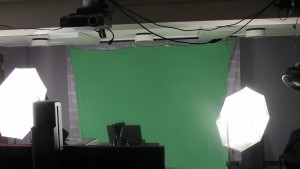In the latest installment of “how-to” (or at least “think about this”) posts about filming your own mini lectures, I discuss the wonderful world of green screens. We have all seen this. Every weather reporter stares at a green (or sometimes blue) screen while using off-camera monitors as guidance. That big weather map behind her: there is nothing there except a blank green screen. This presents those of us making videos with a wonderful opportunity to project an image or images onto a background and then layer live footage or text on top. But there are some things you need to consider before using a green screen.
There are countless videos on YouTube that will show you how to use green screens, but in my opinion, the number one consideration is lighting. We used a green screen that was made of fabric, like a light blanket. I would highly encourage you, if possible, to use a stiffer screen. It was difficult in our studio to prevent undulations in the material and movement as I walked in front of it. The shadows cast by the uneven surface can then mar the image that you superimpose on it. Of course, shadow are caused by uneven lighting.
The corollary to the shadow is the bright spot. In our studio we have tube lighting, but it wasn’t located convenient to the background, so we went with three halogen lamps on tripods and bounced the light off umbrellas to soften and disperse the lighting. Try as we might, we could not get even lighting on the screen. After much trial and error, we were able to minimize it enough so as not to change the superimposed image. A dark or bright spot will “bleed through” any image that you superimpose. Whatever your lighting choices, be cognizant of the presenter’s place in front of the green screen. If the lights are too close or not aligned properly, the presenter’s body will also cast a shadow on the backdrop.
In addition to lighting, you should consider the images you will use and how you want to use them. In our earliest videos, such as the one on Marxism, we “placed” me in places, such as a library. We also at times chose to replace the entire green screen with a single image with me “cut out” of the scene. In latter videos, like those on Romanticism and the Cold War, we replaced the green screen with an image of our college name and then layered more images on top. Doing this, we could advertise Dickinson College, which helped fund our summer’s work, project an image such as the Berlin airlift or Delacroix’s “Liberty Leading the People”. With layering, it was possible to have the Dickinson backdrop, an image, text, and me (the presenter) all at the same time. Students are responding to this latter style in which an image/text is present while I am speaking. This might be because it is a mode of learning with which they are familiar. It mimics the chalk board or PowerPoint illustrating a professor’s ideas during a lecture. Regardless of how many layers you want to use, think about where the presenter will stand. If you have the presenter to the right of the screen, s/he can then gesture to the image that you place on the opposite side of the screen. This provides a sense of movement and interaction that might help hold some students’ attention better. When we moved from editing in iMovie to Final Cut Pro, Aleks was able to “cut” my image from the film and move me to another place on the screen. With this, it was less necessary to have me in the “right” place the first time, but if I had gestured and then we moved me it would not have worked because I might have then gestured in the wrong direction.
Plan as much as you like, you will still have a lot of trial and error with a green screen. I would suggest taking several small test shots and then looking at them in the editing software. After you have practiced, then you can make better initial decisions. If we had done that, we would not have had to reshoot completely the first two episodes on Marxism and the Russian revolutionary movement.
Take a look at our YouTube “Time Capsules” channel, which is also available to Dickinson Scholar (an open source site for scholarship as well as my videos), and let me know if you have any questions about how we did something or why we made the choices we did.
Good luck!
